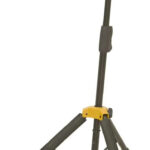The D Sharp Guitar Chord, often referred to as Eb (E flat), is a crucial chord for guitarists to learn. While it might seem less common than some other major chords, understanding and mastering the D# chord opens up a world of musical possibilities. This comprehensive guide will delve into the theory behind the D# chord, explore various ways to play it, and provide tips to enhance your guitar playing.
Understanding the D# Major Chord
The D# Major chord, at its core, is built upon three fundamental notes:
- D# (Root)
- Fx (Major Third) – Enharmonically equivalent to G
- A# (Perfect Fifth)
These notes are derived from the D# Major scale, taking the 1st, 3rd, and 5th degrees. Like all major chords, the D# chord embodies a bright and uplifting quality. The intervals within the chord, starting from the root, are: Major 3rd, minor 3rd, and Perfect 4th (returning to the root in the next octave).
It’s worth noting the enharmonic relationship between D# and Eb. In music theory, these notes represent the same pitch but are named differently depending on the musical context. While both names are correct, Eb is generally favored due to its more common usage in key signatures and musical notation. However, understanding D# is essential, especially when navigating keys like D# Major.
The D# Major chord is the starting point, or the tonic chord, in the key of D# Major. The complete set of chords in this key are:
- D# Major
- E# minor
- Fx minor
- G# Major
- A# Major
- B# minor
- Cx diminished
10 Essential D# Chord Shapes for Guitar
To give you a variety of options, here are 10 different shapes for playing the D# Major chord on the guitar. Experiment with these to find what resonates best with your playing style and the song you’re learning.
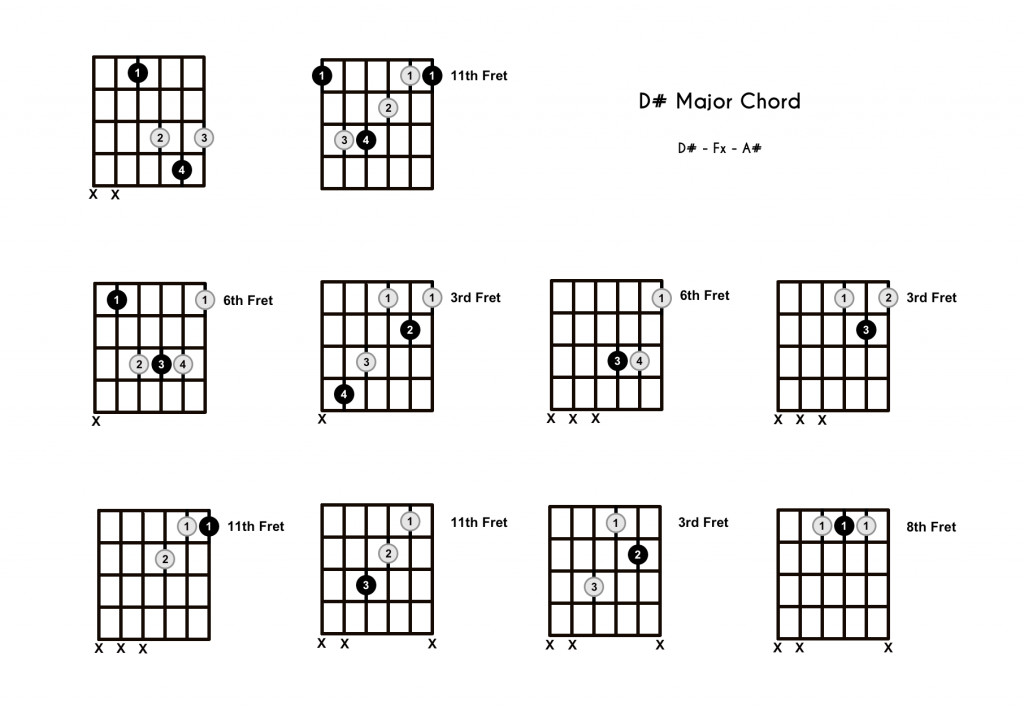 D# Major Chord – 10 Shapes
D# Major Chord – 10 Shapes
The Standard D# Barre Chord Shape
The most frequently used way to play the D# chord is as a root 5 barre chord. This shape is movable, meaning you can play other major chords by simply shifting this shape up and down the fretboard. For D#, you’ll position this barre chord starting on the 6th fret. Often, guitarists will barre across all strings with their index finger, but sometimes, as shown below, the index finger only needs to fret the root note on the 6th string.
 D Sharp Chord Guitar
D Sharp Chord Guitar
The “Easy” D# Chord Shape
If barre chords feel challenging at first, there’s a simplified version of the D# chord. This easy D# chord shape uses only the top three strings. It’s essentially the same shape as the open D chord, just moved up one fret. This makes it a great entry point for beginners to incorporate the D# chord into their playing.
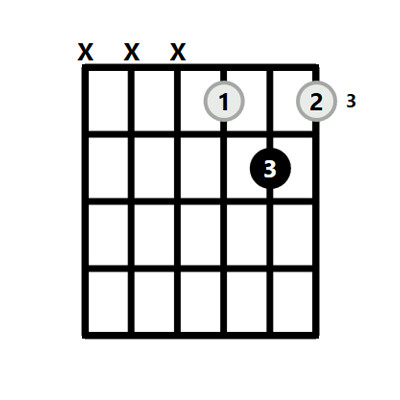 Easy D Sharp Chord Guitar
Easy D Sharp Chord Guitar
Step-by-Step Guide to Playing the Standard D# Chord
Let’s break down the standard D# barre chord shape into easy-to-follow steps:
- First Finger Placement: Place your index finger on the 6th fret of the 5th string.
- Second Finger Placement: Position your middle finger on the 8th fret of the 4th string.
- Third Finger Placement: Place your ring finger on the 8th fret of the 3rd string.
- Fourth Finger Placement: Place your pinky finger on the 8th fret of the 2nd string.
- Strumming: Avoid strumming the 6th string. Strum downwards from the 5th string to the 1st string.
Following these steps carefully can be incredibly helpful, especially when you’re unsure if you’re fretting the chord correctly. Going through each finger placement ensures accuracy and helps build muscle memory for the D# chord shape.
Exploring D# Barre Chord Variations
Beyond the root 5 barre chord, you can also play D# as a root 6 barre chord. This variation starts on the 11th fret and utilizes a different barre chord shape. Mastering both root 5 and root 6 barre shapes provides flexibility and expands your chord vocabulary across the fretboard.
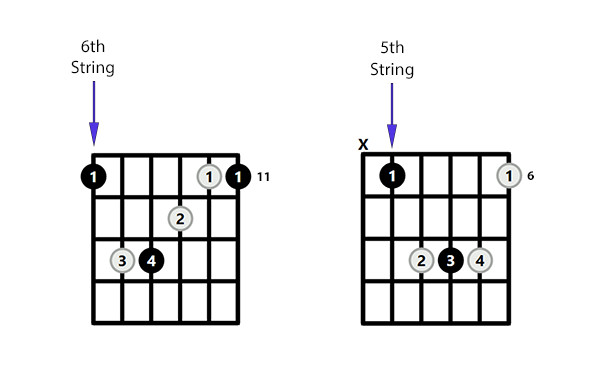 D Sharp Barre Chord Guitar
D Sharp Barre Chord Guitar
D# Major Triads and Inversions
While barre chords are practical for many musical situations, understanding triads offers a deeper insight into chord construction. A D# Major triad consists of the same notes as the full chord (D#, Fx, A#) but played in a more compact voicing, often using only three strings. Triads also have inversions, which change the order of the notes and create different sonic colors. The inversions for the D# Major triad are:
- Root Position: D#, Fx, A#
- 1st Inversion: Fx, A#, D#
- 2nd Inversion: A#, D#, Fx
Here are a few ways to play D# Major triads and their inversions on the guitar:
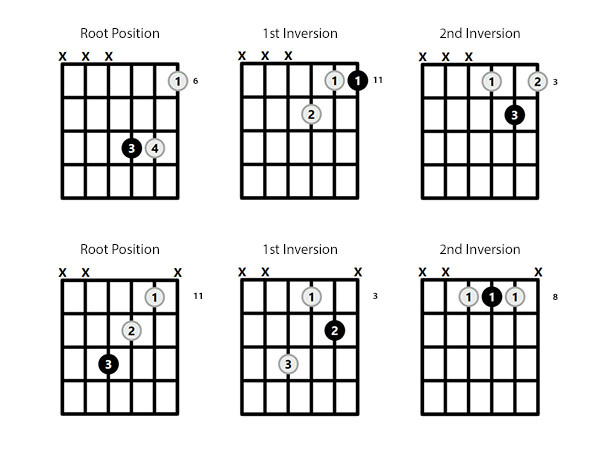 D Sharp Major Triad Guitar
D Sharp Major Triad Guitar
Musical Keys Featuring the D# Chord
Knowing which keys commonly use the D# chord can help you understand its musical context and when you’re likely to encounter it in songs. The D# chord naturally appears in these major keys:
- D# Major: (D#, E#m, Fxm, G#, A#, B#m, Cxdim)
- A# Major: (A#, B#m, Cxm, D#, E#, Fxm, Gxdim)
- G# Major: (G#, A#m, B#m, C#, D#, E#m, Fxdim)
Alternative and Useful D# Chord Voicings
Beyond the standard shapes, there are other alternative D# chord voicings that can add flavor and variety to your playing. These might not be as common as barre chords, but they offer unique sounds and can be useful in specific musical contexts. Experiment with these to expand your sonic palette.
D# Chord Substitutions
In certain musical situations, you can substitute the D# chord with related chords to create interesting harmonic variations. Common substitutions for the D# chord include:
- D# sus4: Adds a suspended fourth interval, creating a slightly unresolved and yearning quality.
- D# sus2: Features a suspended second interval, resulting in a more open and airy sound.
- D# add9: Incorporates the 9th degree of the scale, adding a richer, more complex texture.
Furthermore, the D# Major chord itself can act as a substitute for more complex chords that share D# as the root, such as D# Major 7 or D#7 chords. However, it’s important to note that D# Major cannot substitute for minor chords.
Scales to Solo Over the D# Chord
For guitarists interested in improvisation and lead playing, knowing which scales work well over the D# Major chord is crucial. Effective scales for soloing and creating melodies over D# Major include:
- D# Major Scale: The most fundamental scale, providing a consonant and natural sound.
- D# Major Pentatonic Scale: A simplified version of the major scale, excellent for melodic phrasing and bluesy improvisation.
- D# Blues Scale: Adds a bluesy flavor with flattened 3rd and 5th degrees, creating a soulful and expressive sound.
- D# Lydian Mode: A major scale with a raised 4th degree, offering a brighter and more ethereal quality.
Further Exploration
To deepen your understanding of guitar chords and expand your chord vocabulary, consider exploring resources like “Guitar Chords Galore.”
 Get Guitar Chords Galore eBook
Get Guitar Chords Galore eBook
By mastering the D

